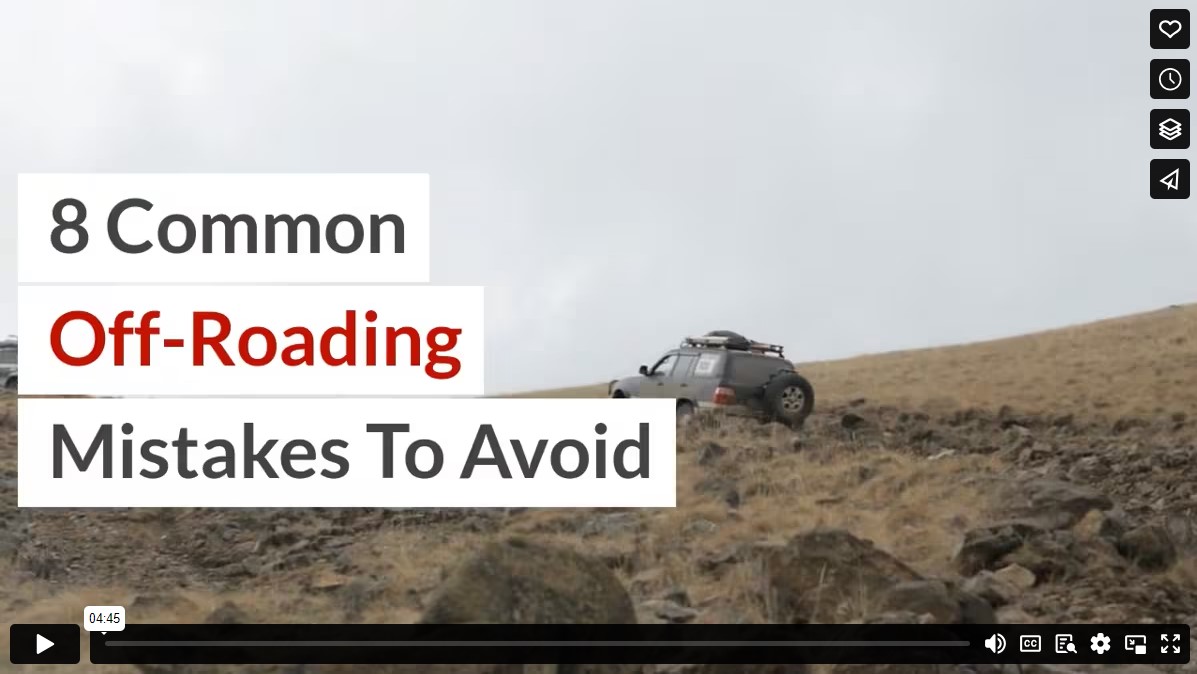Off-roading is a popular outdoor sport for a reason. The adrenaline rush of defeating a challenging climb is thrilling. Unfortunately, like all adventure sports, off-roading is risky. Learning to manage those risks separates the experienced and successful drivers from the amateurs. Your first step is to avoid these all-too-common errors:
1. Not Using The Proper Vehicle
Commuter cars are not designed for off-road driving. You need:
- A vehicle that has clearance to avoid belly scraping and high centering on uneven terrain.
- Tires that can withstand jagged rocks and sudden drops and have tread meant for the trail (sand, mud, etc.).
- An engine that can pull you up a steep incline or out of a ditch. (You’re looking for low-end torque and power rather than speed.)
- A sturdy, wide body that’s less likely to tip.
- A vehicle with adequate approach, departure, and ramp-over angles, meaning the angle at which you can switch from level ground to an incline or back again without getting hung up.
- A vehicle that has appropriately rated recovery points: When (not if) you get bogged down, you need a sturdier attachment than regular transport tie-downs to attach tow cables to pull you out of the mud. That way, the extra weight and drag of the mud doesn’t break the attachment, endangering nearby people and vehicles.
2. Not Planning Your Trip
Part of the thrill of off-roading is being in nature, away from civilization. Isolation is only great when everything is working correctly. Here are some things to keep in mind when planning your next trip.
- Weather: Even a beginner trail can be dangerous in the wrong conditions. Depending on your location, a sudden rain could mean mud bogs or flash floods. A weather forecast and understanding how the weather might affect your trail will significantly reduce your chances of getting stuck or hurt.
- Trails: Knowing the route before you start will help you plan. Before you begin, you can use a map or observe the trail from a high vantage point.
- Supplies: If you get stuck in the middle of nowhere, it may be a few days before you’re found. Proper supplies will aid in your comfort while you wait. The location you are stranded in will decide what supplies you need, but to cover the basics, you should have:
- Food and water for three days.
- A light source and batteries for three days.
- Something to keep you warm overnight like a sleeping bag, campfire starter, and proper clothing.
- Something to get you out of the sun or rain during the day, such as a tarp or tent.
- A way to communicate with an off-road recovery tow truck (like a satellite phone, CB radio, or walkie-talkie).
- A change of clothing and shoes so you’ll be comfortable, especially if you get bogged down and everything is covered in mud.
- GPS so you can stay on course and pinpoint your location for rescue if necessary.
- Trail Buddy: It’s always best to go with a trail buddy who can help you if you get stuck or injured.
3. Aggressive Driving
You want to drive fast enough to make it up the hill without going so fast you can’t stop if you need to at the top. A sudden drop or another vehicle or animal may be just over the rise. Excessive speed and reckless driving are dangerous and can tear up the trail, making it difficult for other drivers.
4. Misjudging The Depth Of Water:
Standing water may appear shallow, but you don’t know how deep the water has penetrated the dirt beneath. You may roll into a pit of sludge and get stuck. Deep water can also damage the vehicle, making it inoperable. When in doubt, turn back.
5. Overloading The Vehicle:
Every vehicle has a maximum capacity for optimal use. Overloading the vehicle with too much gear can strain it or cause it to be unbalanced, making it easier to tip. Know your vehicle and pack accordingly.
6. Buying Cheap Gear:
There are places to skimp if money is tight. Safety isn’t one of them. Any gear you get to protect you or your vehicle should be the best you can afford. It is better to pay a little more upfront for gear than for vehicle repairs and hospital bills later.
7. Ignoring (or not Knowing) the Etiquette:
There are a few unwritten rules to follow to get along with fellow off-road enthusiasts.
- Give the right of way to vehicles going uphill, hikers, dirt bikes, and horses.
- Don’t park in the middle of the trail.
- Give other vehicles space to maneuver.
- Stay on marked trails.
- Whatever you pack in, pack out when you leave. Keep the trail clean for other enthusiasts.
8. Overestimating Skill:
You must understand your skill level. It’s great to push your limits, but go slowly. Don’t let pride overcome common sense if you run into something you’re unsure you can handle. Get more experience and come back to tackle the obstacle another day.
Summary
These tips will help you have a safe trip on your next off-road excursion. If you’re in UT and need an off-road recovery service, call 801-803-4900 for reliable towing.
Video

